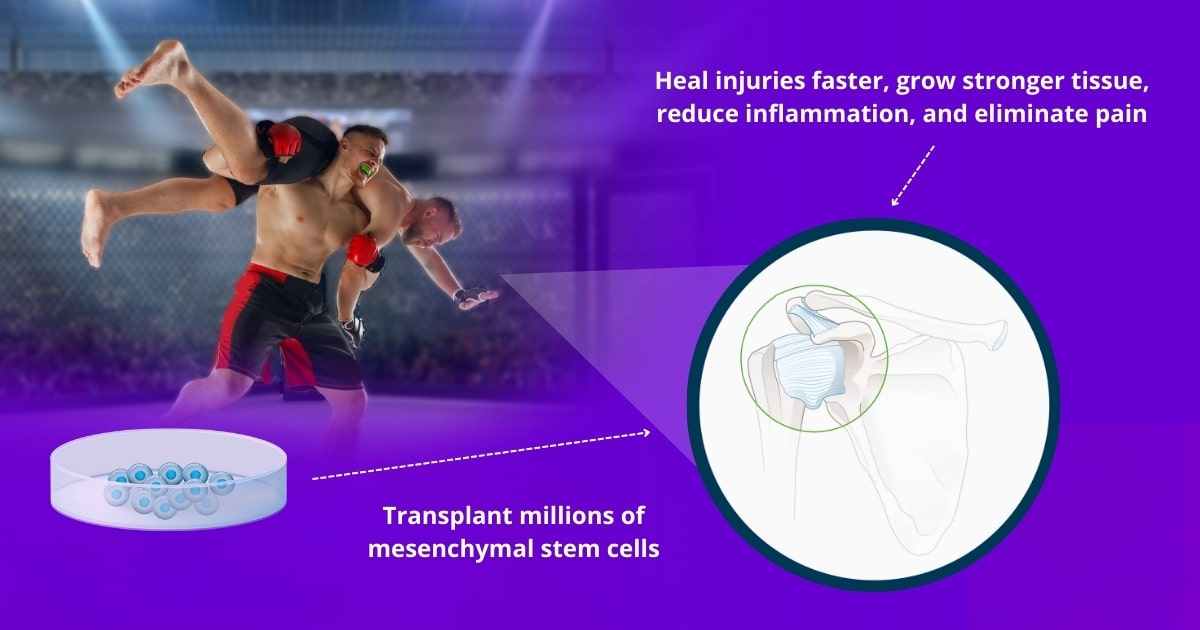Stem Cell Therapy for Sports Injuries
News of pro athletes receiving stem cells to recover from sports injuries has made it a promising approach for orthopedic and repetitive strain injuries. Clinical research has shown that stem cell therapy can help repair sports-related musculoskeletal injuries faster and without surgical intervention. This section will discuss the availability and viability of mesenchymal stem cell therapy for sports-related injuries.


Alternative Medicine By Bars has been featured on:





Stem cell therapy can be used as an alternative to surgery for sports-related injuries such as tendinitis, spine, ACL, joint injuries and rotator cuff tears.
What is Stem Cell Therapy?
Mesenchymal stem cells have been proven to aid the body in regenerating wherever it is needed.
Stem cells can become any type of cell the body needs and repair tissuess at an amazing speed: tendons, ligaments, cartilage, muscles, nerves, bones, organ tissue, brain cells, skin, hair and muscle tissue can regenerate and be repaired at an incredible speed.
Since stem cell therapy can repair damaged tissue, they can help lower the pain and inflammation associated with various conditions. Stem cell treatments have also reduced the need for athletes to get surgery or pain medication.
While medication can be a temporary fix for inflammation and pain, there are many athletes looking to stem cells as a more long-term effective solution over medication.
Stem cell therapy has proven to have considerable success for bone injuries, joint injuries, soft tissue injuries, overuse injuries and osteoarthritis.
Who can get stem cell therapy for sports injuries?
Among those who have experienced life-changing results from stem cell therapy are soccer player Cristiano Ronaldo, pitcher Andrew Heaney, and basketball player Kobe Bryant. At some point in their careers, they all credited stem cell therapy as the reason for their successful and quick recoveries.
Because so many famous athletes have turned to stem cell therapy to treat sports injuries and enhance their performance, word is spreading about the effectiveness of stem cell therapy.
Today, athletes are enjoying longer and more successful careers thanks to advances in regenerative medicine. All sorts of people with an active lifestyle, not just professional athletes, have been able to avoid the scalpel, taking life-long pain relievers, and giving up their active lifestyle.
Professional athletes no longer have to face retirement in younger days. Many pros are adding several more years onto their careers without hesitation. Even after retirement, many athletes no longer have to cope with significant pain from old sports injuries and worn out joints largely due to the regenerative factors that stem cells provide for months or years after transplantation.
An injury can cause debilitating pain, limit movement, and cause a long recovery period which usually causes frustration. Most doctors try to fix the problem with surgery, inactivity, or long-term use of painkillers. Sad to say, but with time, even following that approach, the condition can still get worse. Or medications can start to cause more problems in the body.
Whether you are competing in a professional sport or simply enjoy staying fit and active, the last thing you want is to let an injury stand in the way of your active lifestyle. That’s why stem cell treatments have become a promising alternative to surgery.
What types of sports injuries can be treated with stem cells?
Stem cell treatments for spinal cord injuries
- Severed or damaged spinal cord
- Bulging discs and herniated discs
- Sciatica and back pain
- Muscle weakness and coordination problems
- Partial or complete loss of feeling and mobility
- Peripheral neuropathy, stenosis, and myelopathy
- Impairment of metabolic functions
- Brain trauma, concussion, and neurological degeneration
Stem cell treatments for shoulder injuries
- Rotator cuff tear and cartilage tear
- Repetitive strain and sprain
- Bone fracture
- Frozen shoulder and impingement
- Bursitis and tendonitis
- Treat the root cause of degenerative conditions such as osteoarthritis
- Rebuild tendons, ligaments, and even bone tissue
- Regenerate shoulder ball cartilage
- Repair a ligament or tear
- Reduce inflammation
Stem cell treatments for knee / ankle injuries
- Bone-on-bone or worn cartilage
- Meniscus tear,MCL tear, and ACL tear
- Bone fracture, sprain, bursitis, and tendinitis
- Reduce inflammation
- Rebuild new tendons, ligaments, and even bone tissue
- Treat the root cause of arthritic conditions
Request an in-person or a virtual consultation with a medical specialist to review medical history, lab results, X-rays, MRIs, and determine eligibility for stem cell therapy for sports injuries.
Frequently Asked Questions about Sports Injury

Stem cells are like builder cells, they can form any tissue in the body like bone, cartilage, ligaments, muscles, and nerves.
Regenerative medicine
Why might you need stem cells?
Many athletes suffer chronic injuries due to overuse. Other patients feel the effects of aging or are currently struggling with arthritis or osteoarthritis. With stem cell therapy, these patients have the option treat the injuries without surgery and without undergoing side effects of painkillers.
Many athletes have used stem cell therapy to treat or help recover from several sports injuries such as sprains and strains, broken bones, rotator cuff tears, torn meniscus, tendonitis, back, neck and sciatica pain, among others.
Degenerative diseases
What is Osteoarthirits?
Osteoarthritis affects many people around the world. It is the most common form of degenerative joint disease. Osteoarthritis is traditionally found in hands, hips, knees and spines.
Joint decay due to osteoarthritis can be the result of years of doing the same movement or playing the same sport. The rubbery cartilage that protects our bones wears down and causes bone to rub against bone.
Ethics & safety
Are marrow-derived stem cells ethical and safe for sports injuries?
Using stromal mesenchymal stem cells derived from healthy bone marrow of screened patients (either oneself or an eligible donor) does not raise ethical concerns since the cells are not from discarded in vitro embryos or other questionable sources. Stem cells have been used successfully for years in several clinical studies.
Federal regulations
As Members of the Mayo Clinic Care Network, all of our treatments are performed by qualified medical professional, all transactions are secure, and all information is encrypted because we would never jeopardize patients’ wellbeing nor our long-standing reputation.
Our private laboratory abides by the highest international standards such as COFEPRIS and ISO class 5 and 6. Our clinic is accountable to the COFEPRIS and strictly adheres to proven clinical standards.
Long-lasting results
Do stem cells work for sports injury work?
Stem cells don’t do miracles, but they can far exceed traditional treatments such as surgery or painkillers. Patients from all over the globe have successfully received stem cell therapy for sports injury to regenerate and repair cartilage, bones, tendons, muscle tissue and much more at an amazing rate! The medical field and research have evolved, making stem cell therapy available to you too.
Private Healthcare
Does insurance cover stem cells?
Insurance companies usually do not cover stem cell therapy unless they are for treating certain blood disorders such as a transplant of bone-marrow stem cells to treat leukemia.
It’s important to note that many European and Asian countries have advanced treatments not currently approved for use in the USA. As news spreads about athletes, celebrities, and prestigious professionals undergoing stem cell therapy, treatments options are likely to become less accessible and increasingly privileged.
Unburdened by profit-driven insurance companies, our doctors are able to stay committed to their oath-bound responsibility and never perform unnecessary treatments under the pretense of securing funding. We perform extensive lab work to determine eligibility and identify the exact type, quantity, and application of stem cells that will benefit each patient individually.
Thanks to advances in medicine and scientific research, private sector stem cell therapy such as this is today more accessible in terms of travel, price, and quality.
Sports Injuries: Traditional Treatment Compared to Stem Cell Therapy
- Traditionally, clinicians have been employing a protocol inclusive of protection, rest, ice, compression, and elevation (P.R.I.C.E). This phase basically lets healing take place and controls inflammation.
- Prescription drugs to numb pain receptors.
- Immobilization is sometimes done to help reduce pain, muscle swelling and muscle spasm. As well as to help prevent future damage.
- Corticosteroid injections may be recommended to patients with severe or persistent inflammation. If necessary, a corticosteroid injection can be repeated but it is not recommended to have more than two or three injections per year. Side effects could include loss of fat, infection and thinning of the skin.
- Anti-inflammatory medications.
- Severe injuries may require orthopedic surgery or reconstructive surgery.
- Physical therapy to rehabilitate and strengthen.
- Requires specialist care. May be performed in parallel with current medication.
- Involves administering up to 800 million mesenchymal stem cells via a single spinal cord (intrathecal) injection, intravenously, and/or alternative and regenerative treatments.
- Reduce inflammation and repair damaged tissue continuously for 6-18 months.
- New cells replace dying or damaged cells to restore function and strength.
- Vascular health also is strengthened.
- Intravenous serums nourish and activate the stem cells.
- Cellular therapies such as exosomes help regulate cell differentiation.
- Cost ranges from $4000 to $25,000 per treatment. A single treatment can provide improvement and delay progression for up to 3 years.
Meet Our Doctors & Nurses
Their combined decades of experience in regenerative medicine, sports medicine, alternative treatments, and surgical specialties make our doctors uniquely qualified to develop precision-based medical protocols using mesenchymal stem cells.
Dr. Decio Bars
Chief Medical Director
Dr. Yael Ochoa
Medical Doctor
Carolina Becerra
Registered Nurse
Aaron Torres
Registered Nurse
Request an in-person or a virtual consultation with a medical specialist to review medical history, lab results, X-rays, MRIs, and determine eligibility for stem cell therapy for sports injuries.
Contact a medical specialist
Put your newfound knowledge about alternative medicine treatments to good use. The next step is to complete our secure medical intake form online to request a consultation with a doctor.
The healing of the future is within your reach! We’re very excited for you and will be at your side every step of the way.